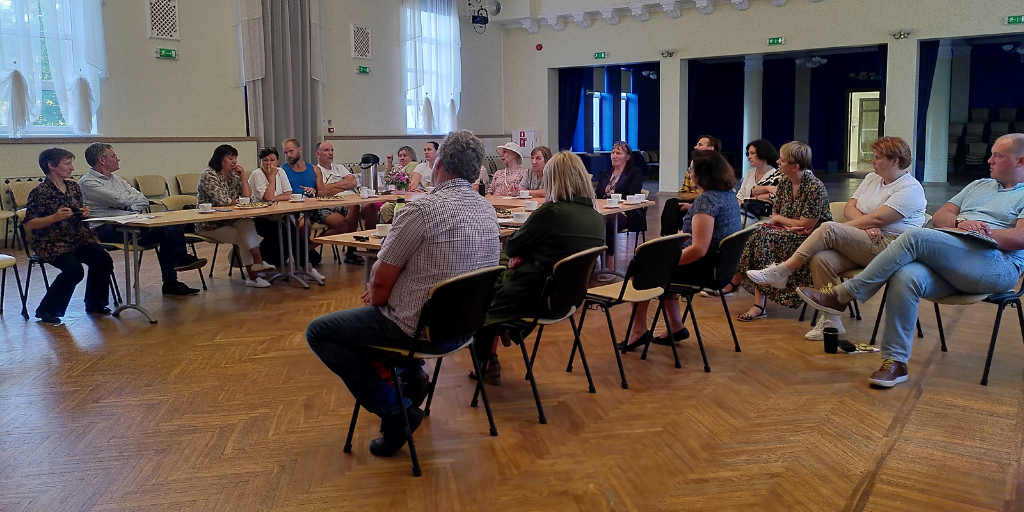On 18 September, I and my fellow colleagues from the Latvian-based environmental organisation Green Liberty teamed up with a researcher from Riga Technical University to visit Viļāni, a small town in eastern Latvia. We met with 20 local people to discuss issues with transport poverty.
Maksis Apinis, National campaigner, Latvia | 2 October 2024

Viļāni, although home to only 2,800 inhabitants, is the only town in the entire Rēzekne region. Comprising rural areas and small villages, Rēzekne region is Latvia’s largest administrative region with a population of 28,300 people.
Transport gaps
Mobility is a challenge not only in Latvia’s sparsely populated countryside but also across much of Europe’s rural areas. Low population density and vast distances between locations often lead to underdeveloped public transport systems.
Infrequent routes, schedules are not always suited well with the daily needs of the locals, and, in some cases, a complete absence of local transport can make daily life difficult. The problem is that, from a public spending point of view, there’s no economic justification for maintaining underutilised public transport routes covering long distances.
Yet, in 2022, Latvia had the lowest number of passenger cars per 1,000 inhabitants in the entire EU, with just 414 cars per 1,000 inhabitants. The EU average was 560, an increase of 14.3 per cent over the last decade. However, instead of increasing their reliance on private cars, it’s vitally important that Latvia and other countries buck the trend. But how?
Breaking the cycle of car dependence
To limit the heating of our planet, the EU transport sector must undergo rapid changes to significantly reduce greenhouse gas emissions. And Latvia is no exception. Its transport sector is the primary emitter of greenhouse gases out of all the sectors in the country not covered by the EU’s Emissions Trading System, making up one-third of all emissions.
The electrification of private cars can only partially offset these emissions, as it wouldn’t be environmentally sustainable or economically feasible to replace the existing car fleet on a one-to-one basis with electric vehicles. It’s clear, then, that dependence on private cars must be reduced.
To achieve this, alternative means of transport must become more available, attractive and convenient. This will require significant investments in public transport, micromobility schemes, and car-sharing practices, rethinking the accessibility of services, and exploring other potential solutions. Indeed, these actions are all the more urgent given the future expansion of the Emissions Trading System, which will include the transport and housing sectors from 2027, is likely to drive up fossil-fuel prices.
Rural life comes under threat
However, the necessary transformation of the transport sector must also be carried out in a socially equitable way. Special attention should be paid to rural areas, where residents tend to be less affluent, already experience transport poverty, and are much more dependent on private cars than city dwellers. As a result, rural populations are also far more vulnerable to policy changes.
From a security perspective, it’s also important to prevent the further depopulation of rural areas, especially those near the Russian border. Viļāni, located just 10 kilometres from where a stray Russian drone crashed on 7 September, highlights this concern. Locals have expressed their fears over security, which is closely tied to mobility.
For instance, the availability of services and the opportunities to attend cultural events in bigger cities, such as Rēzekne, is an important factor for young people when deciding whether to remain in the region. In many ways, mobility is the lifeblood of rural communities such as Viļāni. Without it, they cannot be sustained and, needless to say, raises serious security concerns.
At our meeting, active citizens of Viļāni told us of their daily struggles with mobility and gaining access to services. But they also shared some of the creative solutions they’ve come up with together. The story of ‘Lucia from Sokolki’, a retired lady who owns a car and voluntarily provides transport services to her fellow retirees, serves as a great illustration.
Lucia drives her neighbours wherever they need to go, whether it’s to a doctor’s appointment in Rēzekne or a concert in Daugavpils. But this isn’t an isolated case. Similar examples of community-driven solutions are to be found in many other rural areas.
From the perspectives of EU funding policy and planning, it’s up to decision makers to find the best solutions to help these people, effectively utilise existing resources, and think ‘outside the box’ when tackling transport poverty in the regions.
Actionable insights
Among other suggestions, the locals expressed strong support for developing cycling infrastructure and improving the quality of rural roads, which would greatly enhance their mobility without increasing their dependence on fossil fuel-based transport.
The concept of bringing services to local residents – instead of requiring them to travel to the big cities – was met with great positivity. For instance, setting up shared general practitioners’ offices, where doctors can visit small towns or villages on a regular basis, emerged as one of the most effective solutions.
We were delighted to see the meeting spark so much animated discussion, with locals already brainstorming on solutions they mighty implement independently. The insights gained from the meeting will certainly be reflected in the roadmap for reducing transport poverty in Rēzekne region, which researchers from Riga Technical University will develop by the end of this year.
Never miss an update
We expose the risks of international public finance and bring critical updates from the ground – straight to your inbox.
